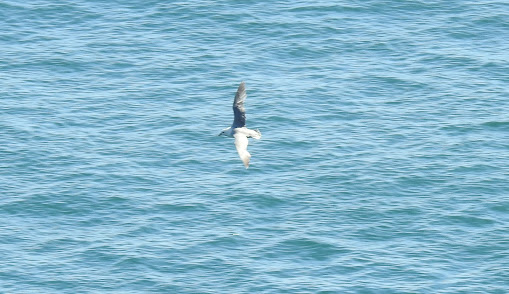Saturday 24th June 2023.
Well, it was time for our annual trip to Durlston Head for the Puffins etc., and although things didn't go according to the script, we still had a superb day at this fantastic site. I had earlier met John Goodall at the Farlington Marshes Car Park and met John Cronin later on at the reserve, as the three of us went in search for our annual ‘year-tick’ of the Puffins for my 12th year running. However, a thick blanket of Sea Fog had rolled in early this morning and although it cleared for a brief time, it came back thicker than ever and the sea soon became engulfed and visibility over the sea was impossible. This was most likely caused by warm, moist air flowing over the colder sea resulting in Sea Fog to form. Hurrumph! On our way to Durlston Head, we saw sightings of a Sparrowhawk, Kestrel and a Green Woodpecker flying over the road!
Despite spending at least 90 minutes in our usual spot just west of Dancing Ledge (which was full of noisy kids and young adults), we saw no Puffins whatsoever. I believe that this was the first trip here that we did not see the birds and though disappointing, we still got to see a wealth of other birds as well as the other superb wildlife here and even a real unexpected surprise as we were making our way east back along the top fields to the Lighthouse.
Like last year, I shall let the photos do the talking as I did take quite a few again. I have to be honest, as I am nearing 60 years of age, I was struggling a bit this time on our walk back and carrying a lot more weight around the midriff did not help either! But give a thought to both the ‘Johns’ who are a lot older than me who did not complain once on the way back about fatigue. Well done guys. The view from the top of the hill looking down was somewhat spectacular as the fog had covered the sea and looked reminiscent of looking out of an aircraft window down on the clouds. Amazing.
But not lets forget the wildlife. We had the most amazing views of the Peregrines; countless numbers and variety of butterflies and the plant life was simply staggering. When we got to the top of the infamous hill to start walking eastbound by the fields, the sun was ablaze with the most beautiful blue sky imaginable. It really was a naturalist's paradise and its here in the UK too.
The surprise bird was a Quail! We were walking along the top fields along the main footpath and there was a sudden rush of flapping wings that was so typical of a game bird and I turned round quickly to notice a small game bird flying up and away between me and the guys and then head off north. It was too close for binoculars and I got the best of views of the bird as it disappeared over to the field to the north and quickly yelled out Quail to the other guys. That was a ‘lifer’ species for them and only my second ever seen. Talking to birding pal Geoff Farwell; he thinks it was a non-breeding bird or a late arrival. Just goes to show again, that anything could turn up at any time.
We had a good day with the local Butterflies species seen today that included the following:
- Dark-green Fritillary (NFY)
- Small Tortoiseshell
- Small White
- Marbled White
- Meadow Brown
- Lulworth Skipper
- Essex Skipper
- Large Skipper
- Small Skipper
- Speckled Wood
- Common Blue
- Adonis Blue
- Small Heath
We rounded the trip off with another look at the bird life by the viewing platforms where the fog had started lifting and we got to see the birds a lot clearer now. Both the Guilemots and Razorbills were now showing clearly on both the cliffs and on the sea and we even saw an adult Guillemot (which should of known better), swim too close to a loafing Great Black-backed Gull on the water, which swiftly grabbed the bird and tried to drown it. However, the Guillemot somehow escaped to live another day! Both and adult and juvenile Peregrine showed very well in the sunshine and a Fulmar wheeled around the cliffs below. Other notable birds seen today included two family flocks of Dartford Warbler, Common Whitethroat, Raven, Yellowhammer, two distant immature Gannets heading east, a couple of Mediterranean Gulls over the sea (when there was a clear spell from the fog!) and up to 3 Oystercatchers.
John Goodall bought us all an ice cream from the cafe where we had great views overlooking the sea and nearby Bournemouth in the distance. Earlier, I got my fourth ‘year-tick’ of the day (Fulmar, Guillemot and Quail also were 'year-ticks').when I spotted something giving off its alarm call deep within some Suada by the main footpath. It popped out briefly and it turned out to be a Lesser Whitethroat that eventually flew off north into the trees opposite. On the way back to the car, a Chiffchaff was in full song on top of a dead tree to round off a wonderful day at this special place.


















































No comments:
Post a Comment